Geology and Genesis of Xianglushan Fe-Cu Orefield in Sichuan (SW China): Evidence from C-O-S-Pb Isotopes
Abstract
:1. Introduction
2. Regional Geological Background
3. Deposit Geology
3.1. Stratigraphy and Structures
3.2. Alteration and Mineralization Features
4. Methods and Results
4.1. Methods
4.2. Fluid Inclusion Types and Features
4.3. Microthermometric Results
4.4. Compositions of Fluid Inclusions
4.5. Carbon and Oxygen Isotopes
4.6. Sulfur and Lead Isotopes
5. Discussion
5.1. Ore-Forming Material and Fluid Source
5.2. Ore Deposit Type and Genesis
6. Conclusions
Author Contributions
Funding
Acknowledgments
Conflicts of Interest
References
- Zhao, X.F.; Zhou, M.F.; Li, J.W.; Sun, M.; Gao, J.F.; Sun, W.H.; Yang, J.H. Late Paleoproterozoic to early Mesoproterozoic Dongchuan Group in Yunnan, SW China: Implications for tectonic evolution of the Yangtze Block. Precambrian Res. 2010, 182, 57–69. [Google Scholar] [CrossRef]
- Peng, M.; Wu, Y.B.; Gao, S.; Zhang, H.F.; Wang, J.; Liu, X.C.; Gong, H.J.; Zhou, L.; Hu, Z.C.; Liu, Y.S.; et al. Geochemistry, Zircon U-Pb Age and Hf Isotope Compositions of Paleoproterozoic Aluminous A-type Granites form the Kongling Terrain, Yangtze Block: Constraints on Petrogenesis and Geologic Implications. Gondwana Res. 2012, 22, 140–151. [Google Scholar] [CrossRef]
- Zhang, D.L.; Huang, D.Z.; Zhang, H.F.; Wang, G.Q.; Du, G.F. Chronological framework of basement beneath the Xianmgzhong Basin: Evidence by U-Pb ages of detrital zircons from Xikuangshan. Acta Petrol. Sin. 2016, 32, 3456–3468. (In Chinese) [Google Scholar]
- Greentree, M.R.; Li, Z. The oldest known rocks in south western China: SHRIMP U-Pb magmatic crystallization age and detrital provenance analysis of the Paleoproterozoic Dahongshan Group. J. Asian Earth Sci. 2008, 33, 289–302. [Google Scholar] [CrossRef]
- Sun, W.H.; Zhou, M.F.; Gao, J.F.; Yang, Y.H.; Zhao, X.F.; Zhao, J.H. Detrital zircon U-Pb geochronological and Lu–Hf isotopic constraints on the Precambrian magmatic and crustal evolution of the western Yangtze Block, SW China. Precambrian Res. 2009, 172, 99–126. [Google Scholar] [CrossRef]
- Greentree, M.R.; Li, Z.X.; Li, X.H.; Wu, H. Late Mesoproterozoic to earliest Neoproterozoic basin record of the Sibao Orogenesis in western South China and relationship to the assembly of Rodinia. Precambrian Res. 2006, 151, 79–100. [Google Scholar] [CrossRef]
- Fan, H.P.; Zhu, W.G.; Li, Z.X.; Zhong, H.; Bai, Z.J.; He, D.F.; Chen, C.J.; Cao, C.Y. Ca. 1.5 Ga mafic magmatism in South China during the break-up of the supercontinent Nuna/Columbia: The Zhuqing Fe-Ti-V oxide ore-bearing mafic intrusions in western Yangtze Block. Lithos 2013, 16, 85–98. [Google Scholar] [CrossRef]
- Chen, W.T.; Zhou, M.F.; Gao, J.F.; Hu, R.Z. Geochemistry of magnetite from Proterozoic Fe-Cu deposits in the Kangdian metallogenic province, SW China. Miner. Depos. 2015, 50, 795–809. [Google Scholar] [CrossRef]
- Zeng, M.; Zhang, D.; Zhang, Z.; Li, T.; Li, C.; Wei, C. Structural controls on the Lala Iron-Copper Deposit of the Kangdian metallogenic province, southwestern China: Tectonic and metallogenic implications. Ore Geol. Rev. 2018, 97, 35–54. [Google Scholar] [CrossRef]
- Zhao, X.F.; Zhou, M.F. Fe–Cu deposits in the Kangdian region, SW China: a Proterozoic IOCG (iron-oxide–copper–gold) metallogenic province. Miner. Depos. 2011, 46, 731–747. [Google Scholar] [CrossRef]
- Gong, L. The metallogenetic rule and prospecting of middle Proterozoic Cu–Fe metallogenetic zone in central Yunnan. Yunnan Geol. 2011, 30, 255–260. (In Chinese) [Google Scholar]
- Liu, W.; Yang, X.; Shu, S.; Liu, L.; Yuan, S. Precambrian Basement and Late Paleoproterozoic to Mesoproterozoic Tectonic Evolution of the SW Yangtze Block, South China: Constraints from Zircon U–Pb Dating and Hf Isotopes. Minerals 2018, 8, 333. [Google Scholar] [CrossRef]
- Wang, D.B.; Yin, F.G.; Sun, Z.M.; Wang, L.Q.; Wang, B.D.; Liao, S.Y.; Tang, Y.; Ren, G.M. Zircon U-Pb age and Hf isotope of Paleoproterozoic mafic intrusion on the western margin of the Yangtze Block and their implications. Geol. Bull. China 2013, 32, 617–630. (In Chinese) [Google Scholar]
- Zhu, H.; Fan, H.; Fan, W.; Zhou, B.; Wang, S.; Luo, M.; Liao, Z.; Guo, Y. Assessing Precambrian stratigraphic sequence of Dongchuan area: Evidence from zircon SHRIMP and LA-ICP-MS dating. Geol. J. Chin. Univ. 2011, 17, 452–461. (In Chinese) [Google Scholar]
- Zhou, B.; Wang, S.; Sun, X.; Liao, Z.; Guo, Y.; Jiang, X.; Zhu, H.; Liu, M.; Ma, D.; Shen, Z.; et al. SHRIMP U-Pb age and its significance of zircons in welded tuff of Wangchang formation in Dongchuan area, Yunnan province, SW China. Geol. Rev. 2012, 58, 359–368. (In Chinese) [Google Scholar]
- Hu, Z.C.; Liu, Y.S.; Gao, S.; Liu, W.G.; Zhang, W.; Tong, X.R.; Lin, L.; Zong, K.Q.; Li, M.; Chen, H.H.; et al. Improved in situ Hf isotope ratio analysis of zircon using newly designed X skimmer cone and Jet sample cone in combination with the addition of nitrogen by laser ablation multiple collector ICPMS. J. Anal. Atom. Spectrom. 2012, 27, 1391–1399. [Google Scholar] [CrossRef]
- Wang, L.J.; Griffin, W.L.; Yu, J.H.; O’Reilly, S.Y. U-Pb and Lu-Hf Isotopes in Detrital Zircon from Neoproterozoic Sedimentary Rocks in the Northern Yangtze Block: Implications for Precambrian Crustal Evolution. Precambrian Res. 2013, 23, 1261–1272. [Google Scholar] [CrossRef]
- Wang, W.; Zhou, M.F. Provenance and tectonic setting of the Paleo-Mesoproterozoic Dongchuan Group in the southwestern Yangtze Block, South China: Implication for the breakup of the supercontinent Columbia. Tectonophysics 2014, 610, 110–127. [Google Scholar] [CrossRef]
- Yang, H.; Liu, P.H.; Meng, E.; Wang, F.; Xiao, L.L.; Liu, C.H. Geochemistry and its tectonic implications of metabasite in the Dahongshan Group in southwestern Yangtze block. Acta Petrol. Sin. 2014, 30, 3021–3033. (In Chinese) [Google Scholar]
- Gong, L.; He, Y.; Chen, T.; Zhao, Y. Proterozoic Rift Type Copper Deposit in Dongchuan, Yunnan; Wang, X., Ed.; Metallurgical Industry Press: Beijing, China, 1996; pp. 6–50. (In Chinese) [Google Scholar]
- Wang, S.; Liao, Z.; Sun, X.; Zhou, Q.; Wang, B.; Wang, Z.; Guo, Y.; Jiang, X.; Yang, B.; Lu, S. The Yanshanian Lithospheric Evolution in Kangdian Area—Restriction from SHRIMP Zircons U–Pb Age and Geochemistry of Mafic Dykes in Dongchuan, Yunnan Province, SW China. Acta Petrol. Sin. 2014, 88, 299–317. (In Chinese) [Google Scholar]
- Brown, P.E.; Lamb, W.M. P-V-T properties of fluids in the system H2O ± CO2 ± NaCl: New graphical presentations and implications for fluid inclusion studies. Geochim. Cosmochim. Acta 1989, 53, 1209–1221. [Google Scholar] [CrossRef]
- Wang, L.J. Analysis and study of the composition of fluid inclusions. Geol. Rev. 1998, 44, 496–501. (In Chinese) [Google Scholar]
- Zhu, H.P.; Wang, L.J.; Liu, J.M. Determination of quadruple mass spectrometer for gaseous composition of fluid inclusion from different mineralization stages. Acta Petrol. Sin. 2003, 19, 314–318. (In Chinese) [Google Scholar]
- Guo, L.; Hou, L.; Liu, S.; Nie, F. Rare Earth Elements Geochemistry and C–O Isotope Characteristics of Hydrothermal Calcites: Implications for Fluid-Rock Reaction and Ore-Forming Processes in the Phapon Gold Deposit, NW Laos. Minerals 2018, 8, 438. [Google Scholar] [CrossRef]
- Yuan, S.; Peng, J.; Li, X.; Peng, Q. Carbon, Oxygen and Strontium Isotope geochemistry of calcites from the Xianghualing Tin-Polymetallic Deposit, Hunan Province. Acta Geol. Sin. 2008, 82, 1522–1530. (In Chinese) [Google Scholar]
- Liu, Q.; Shao, Y.; Liu, Z.; Zhang, J.; Wang, C. Origin of the Granite Porphyry and Related Xiajinbao Au Deposit at Pingquan, Hebei Province, Northeastern China: Constraints from Geochronology, Geochemistry, and H–O–S–Pb–Hf Isotopes. Minerals 2018, 8, 330. [Google Scholar] [CrossRef]
- Wu, J.H.; Li, H.; Algeo, T.J.; Jiang, W.C.; Zhou, Z.K. Genesis of the Xianghualing Sn–Pb–Zn deposit, South China: A multi-method zircon study. Ore Geol. Rev. 2018, 102, 220–239. [Google Scholar] [CrossRef]
- Li, H.; Wu, Q.H.; Evans, N.J.; Zhou, Z.K.; Kong, H.; Xi, X.S.; Lin, Z.W. Geochemistry and geochronology of the Banxi Sb deposit: Implications for fluid origin and the evolution of Sb mineralization in central-western Hunan, South China. Gondwana Res. 2018, 55, 112–134. [Google Scholar] [CrossRef]
- Todt, W.; Cliff, R.A.; Hanser, A.; Hofmann, A.W. Evaluation of a 202Pb-205Pb double spike for high-precision lead isotope analysis. Geophys. Monograph Ser. 1996, 95, 429–437. [Google Scholar]
- Lu, H.Z.; Fan, H.R.; Ni, P.; Ou, X.; Shen, K.; Zhang, W. Fluid Inclusions; Hu, X., Hu, S., Eds.; Science Press: Beijing, China, 2004; pp. 1–48. [Google Scholar]
- O’Neil, J.R.; Clayton, R.N.; Mayade, T.K. Oxygen isotope fractionation in divalent metal carbonates. J. Chem. Phys. 1969, 51, 5547–5558. [Google Scholar] [CrossRef]
- Sun, J.G.; Hu, S.X.; Shen, K. Research on C, O isotopic geochemistry of intermediate-basic and intermediate-acid dykes in gold fields of Jiaodong Peninsular. Acta Petrol. Mineral. 2001, 20, 46–56. (In Chinese) [Google Scholar]
- Deines, P. Stable isotope variations in carbonatites. In Carbonatites: Genesis and Evolution; Bell, K., Ed.; Springer: Berlin/Heidelberg, Germany, 1989; pp. 301–359. [Google Scholar]
- Taylor, H.P.; Frechen, J.; Degens, E.T. Oxygen and carbon isotope studies of carbonatites from the Laacher See District, West Germany and the Alnö District, Sweden. Geochim. Cosmochim. Acta 1967, 31, 407–431. [Google Scholar] [CrossRef]
- Demény, A.; Ahijado, A.; Casillas, R.; Vennemannc, T.W. Crustal contamination and fluid/rock interaction in the carbonatites of Fuerteventura (Canary Islands, Spain): A C, O, H isotope study. Lithos 1998, 44, 101–115. [Google Scholar] [CrossRef]
- Hoefs, J. Stable Isotope Geochemistry; Springer Science & Business Media: Berlin/Heidelberg, Germany, 2008. [Google Scholar]
- Li, R.; Chen, H.; Xia, X.; Yang, Q.; Danyushevsky, L.V.; Lai, C.K. Using integrated in-situ sulfide trace element geochemistry and sulfur isotopes to trace ore-forming fluids: Example from the Mina Justa IOCG deposit (southern Perú). Ore Geol. Rev. 2018, 101, 165–179. [Google Scholar] [CrossRef]
- Monteiro, L.; Xavier, R.; Carvalho, E.; Hitzman, W.; Johnson, C.; Souza, F.; Torresi, I. Spatial and temporal zoning of hydrothermal alteration and mineralization in the Sossego iron oxide-copper-gold deposit, Carajás Mineral Province, Brazil: Paragenesis and stable isotope constraints. Miner. Depos. 2008, 43, 129–159. [Google Scholar] [CrossRef]
- Han, J.; Chen, H.; Jiang, H.; Zhao, L.; Zhang, W.; Lai, C.K. Genesis of the Paleozoic Aqishan-Yamansu arc-basin system and Fe (-Cu) mineralization in the Eastern Tianshan, NW China. Ore Geol. Rev. 2019, 105, 55–70. [Google Scholar] [CrossRef]
- Liang, P.; Chen, H.; Han, J.; Wu, C.; Zhang, W.; Xu, D.; Lai, C.K.; Kyser, K. Iron oxide-copper-gold mineralization of the Devonian Laoshankou deposit (Xinjiang, NW China) in the Central Asian Orogenic Belt. Ore Geol. Rev. 2019, 104, 628–655. [Google Scholar] [CrossRef]
- Zhang, W.; Chen, H.; Peng, L.; Zhao, L.; Huang, J.; Lu, W.; Liang, P.; Lai, C. Discriminating hydrothermal fluid sources using tourmaline boron isotopes: Example from Bailingshan Fe deposit in the Eastern Tianshan, NW China. Ore Geol. Rev. 2018, 98, 28–37. [Google Scholar] [CrossRef]
- Chen, W.T.; Zhou, M.F. Paragenesis, Stable Isotopes, and Molybdenite Re-Os Isotope Age of the Lala Iron-Copper Deposit, Southwest China. Econ. Geol. 2012, 107, 459–480. [Google Scholar] [CrossRef]
- Chen, H.; Kyser, T.K.; Clark, A.H. Contrasting fluids and reservoirs in the contiguous Marcona and Mina Justa iron oxide-Cu (-Ag-Au) deposits, south-central PerA (0). Miner. Depos. 2011, 46, 677–706. [Google Scholar] [CrossRef]
- Williams, P.J.; Barton, M.D.; Johnson, D.A.; Fontbote, L.; De Haller, A.; Mark, G.; Oliver, N.H.S.; Marschik, R. Iron oxide copper-gold deposits: Geology, space-time distribution, and possible modes of origin. Econ. Geol. 2005, 100, 371–405. [Google Scholar]
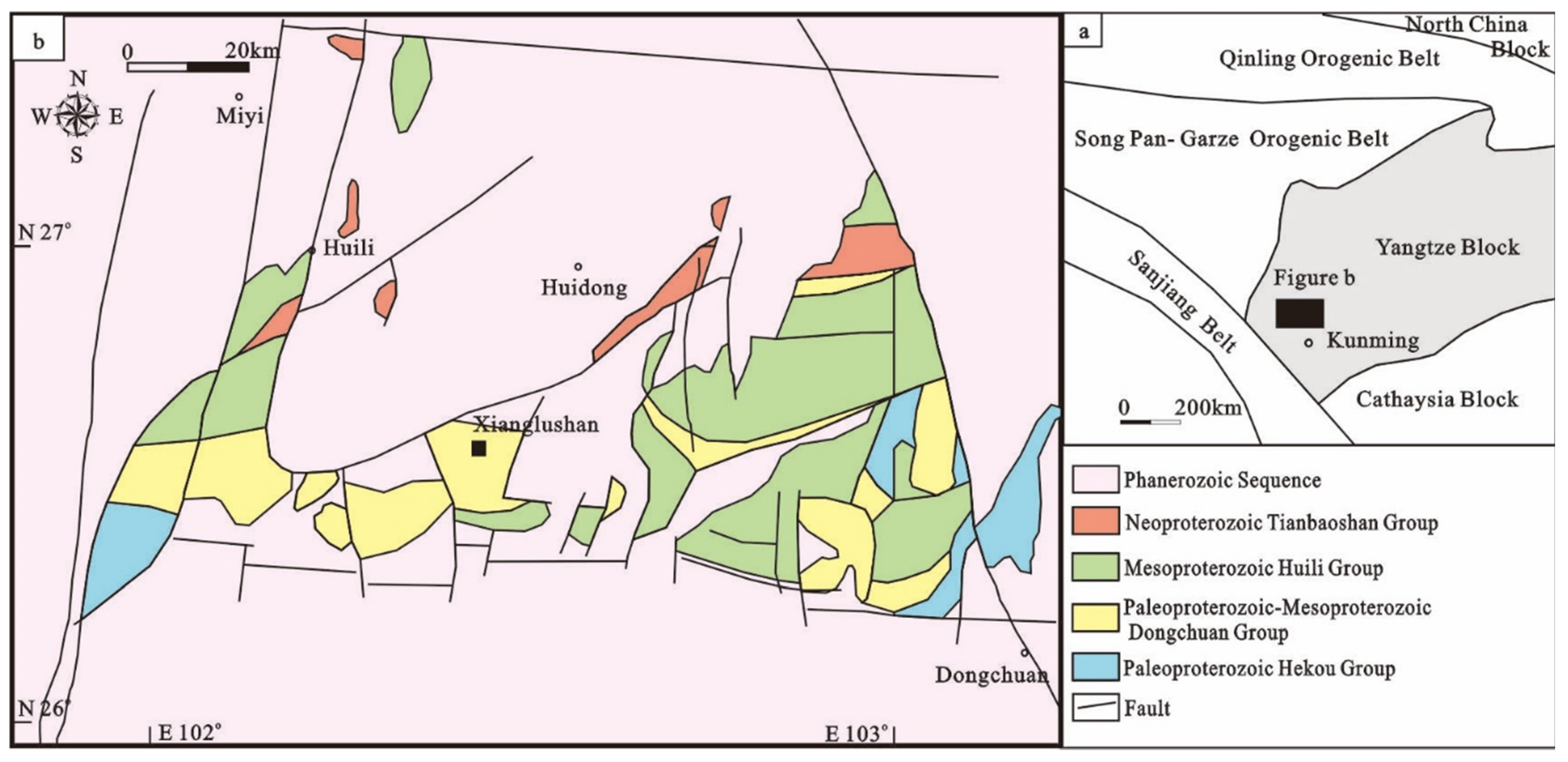
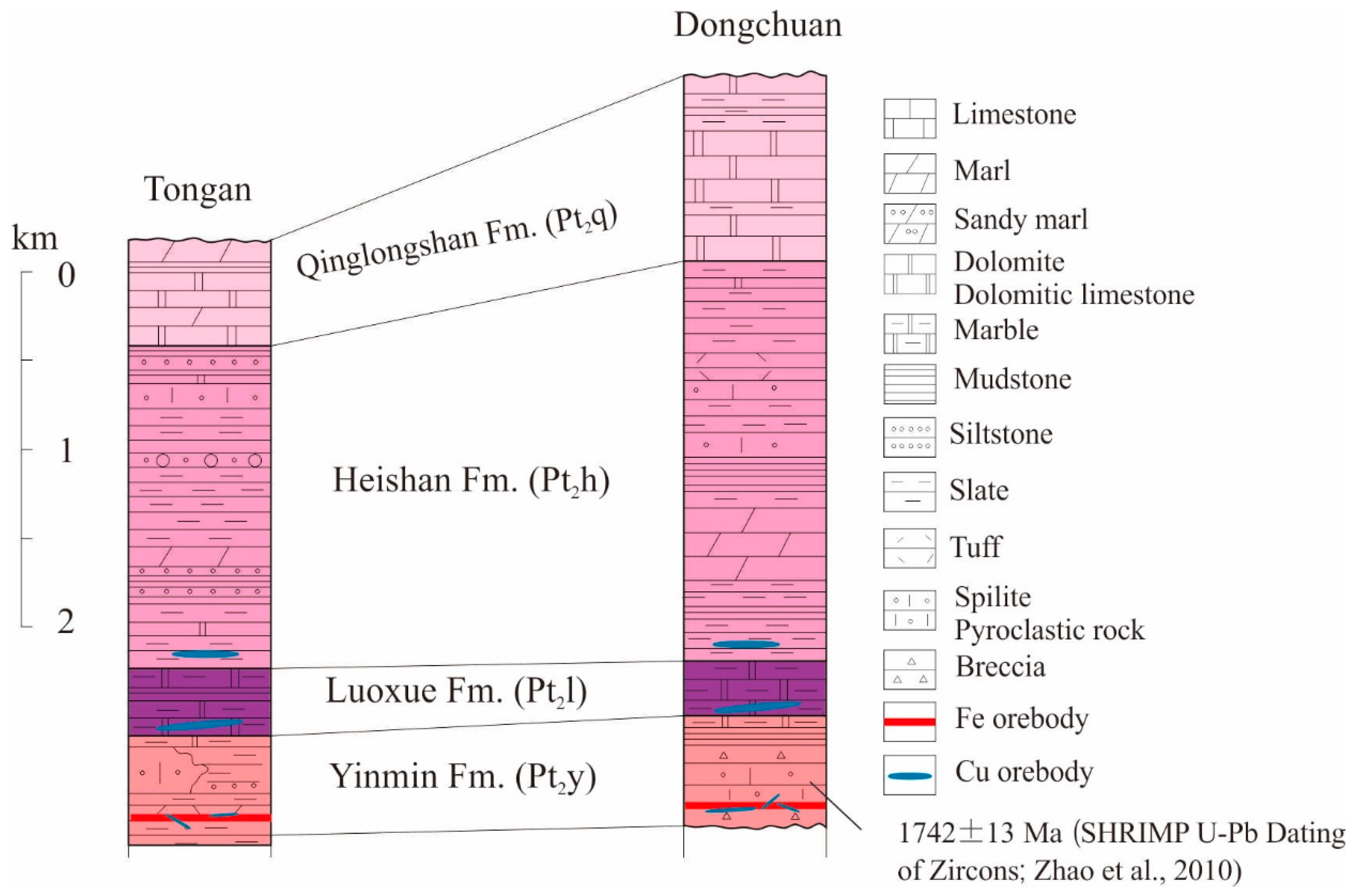

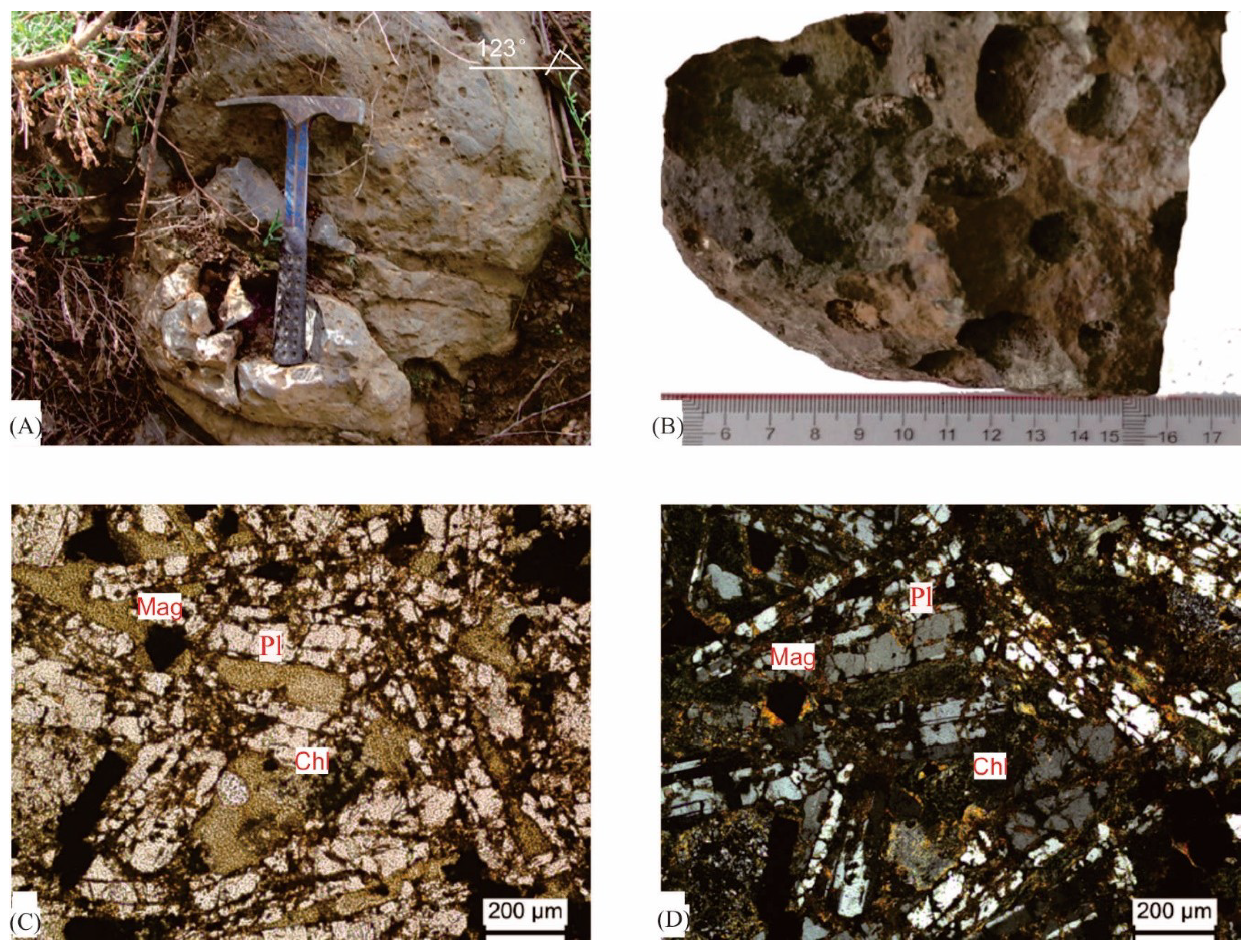
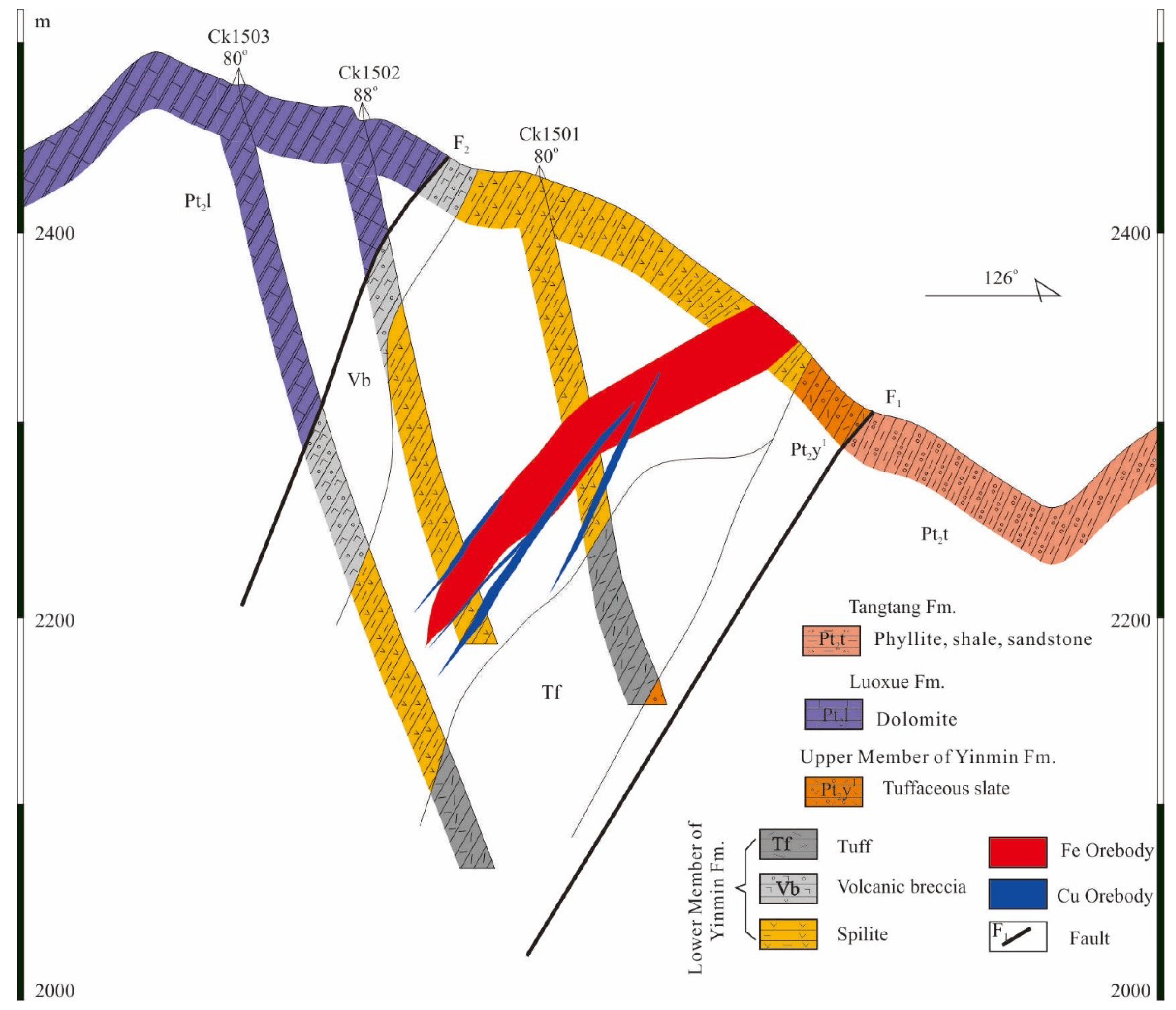

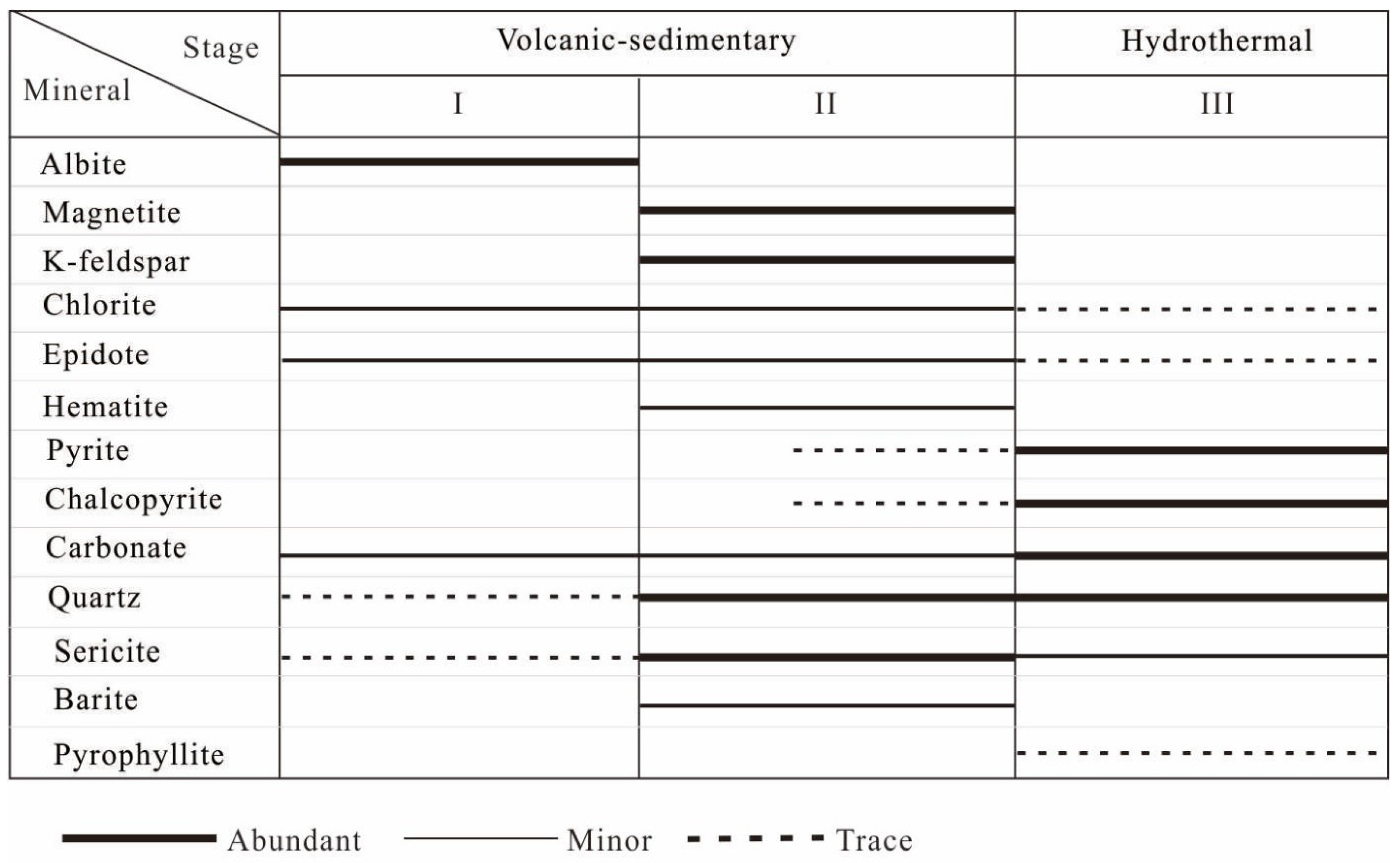
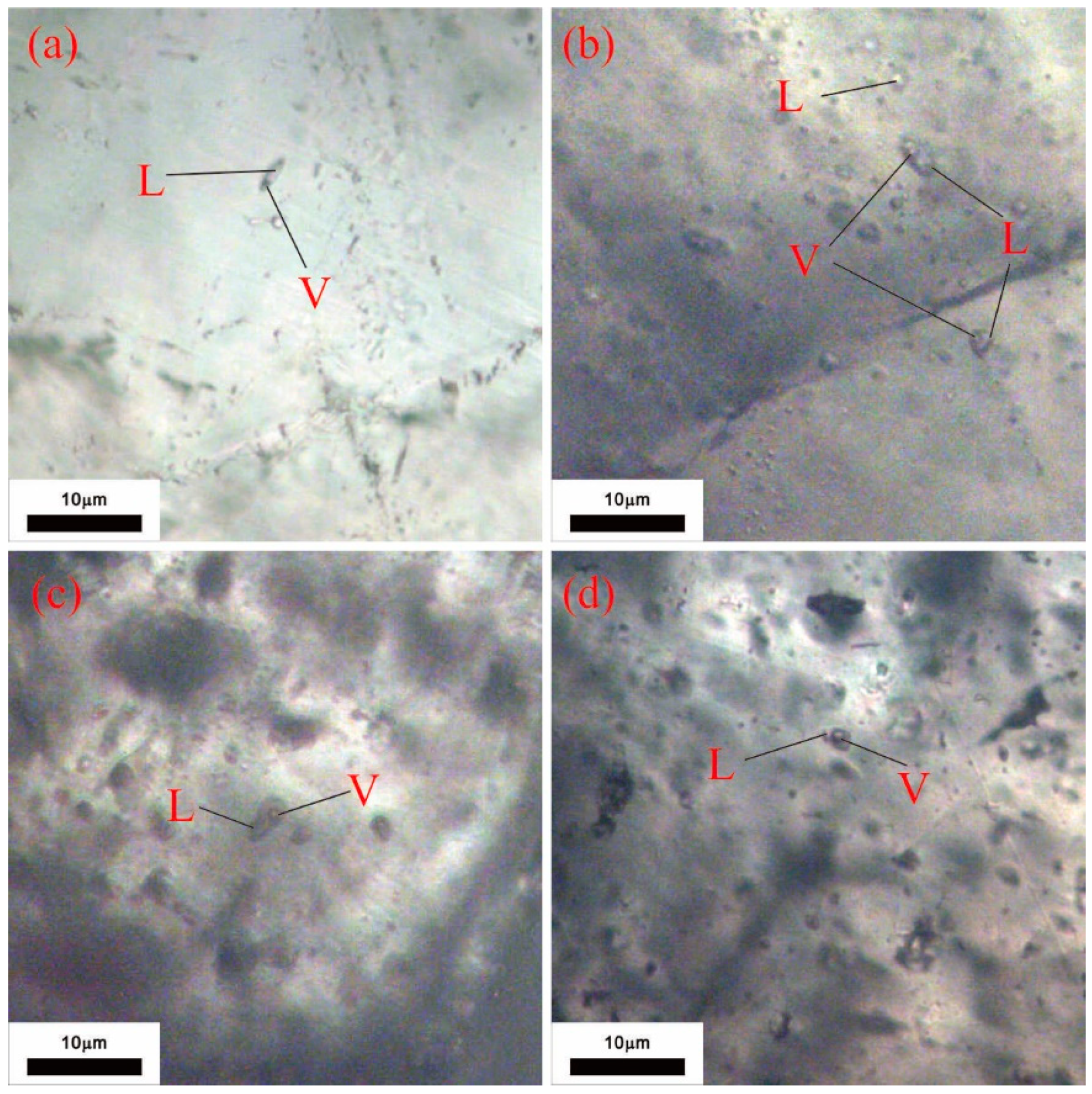
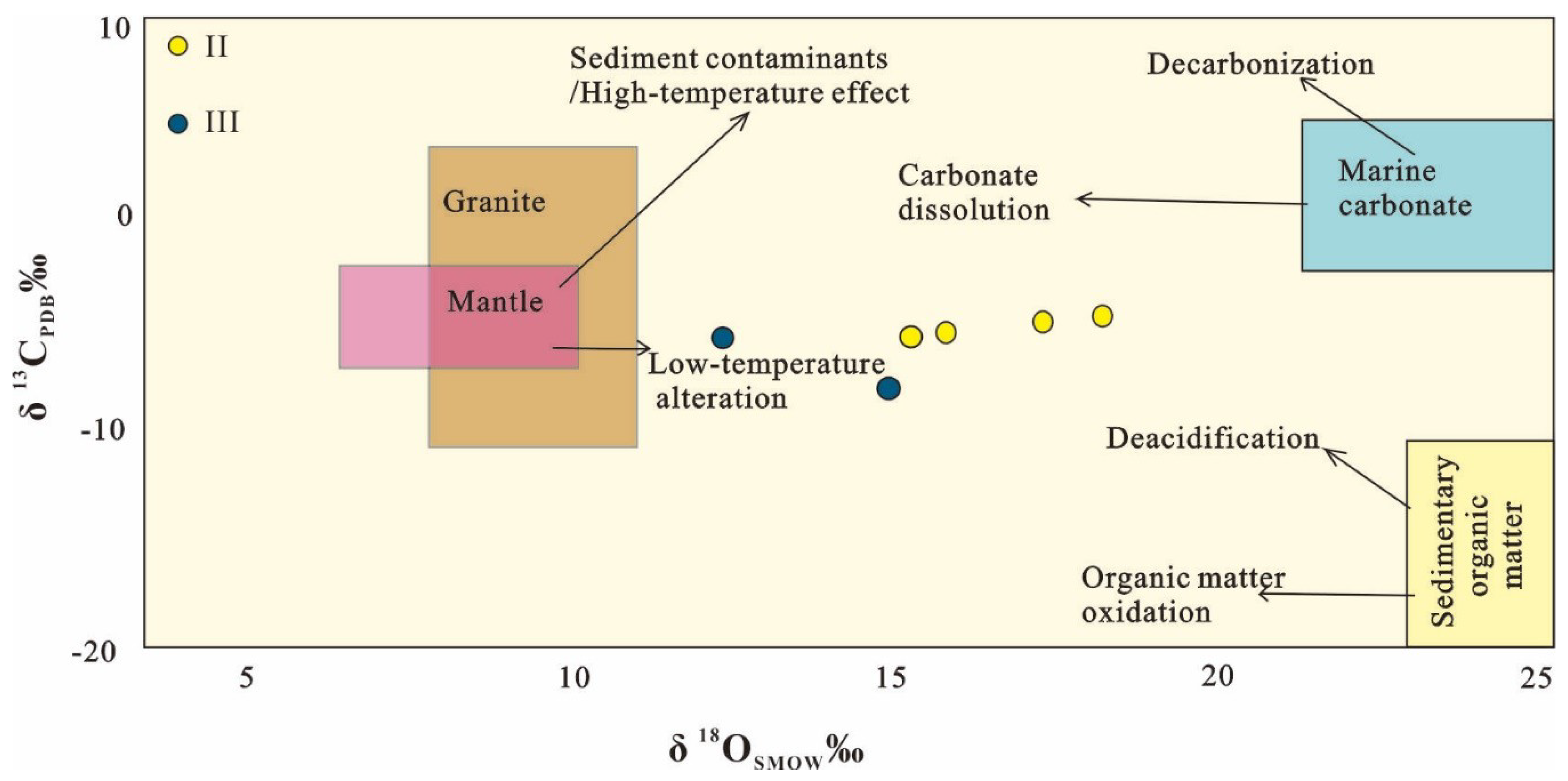
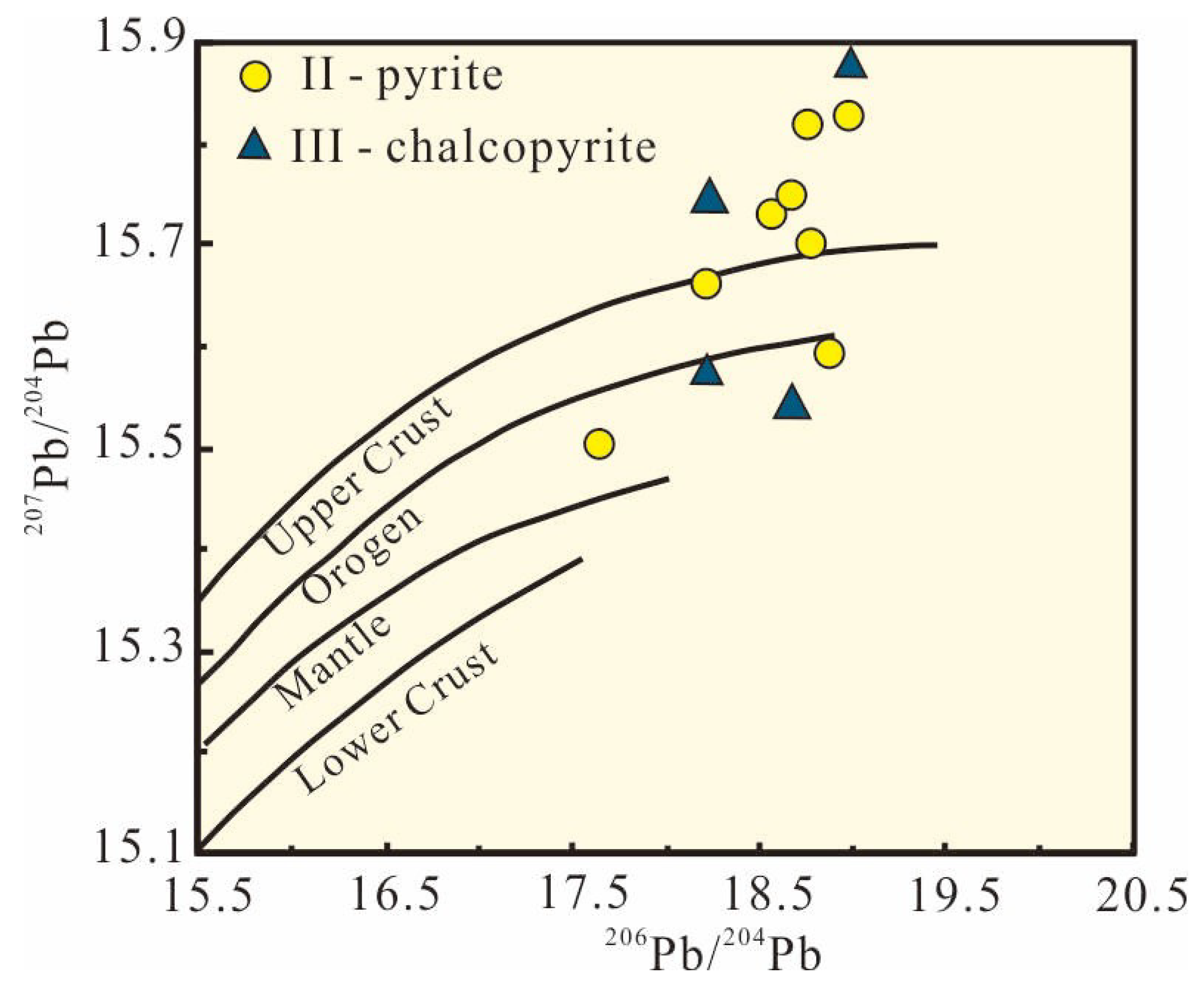
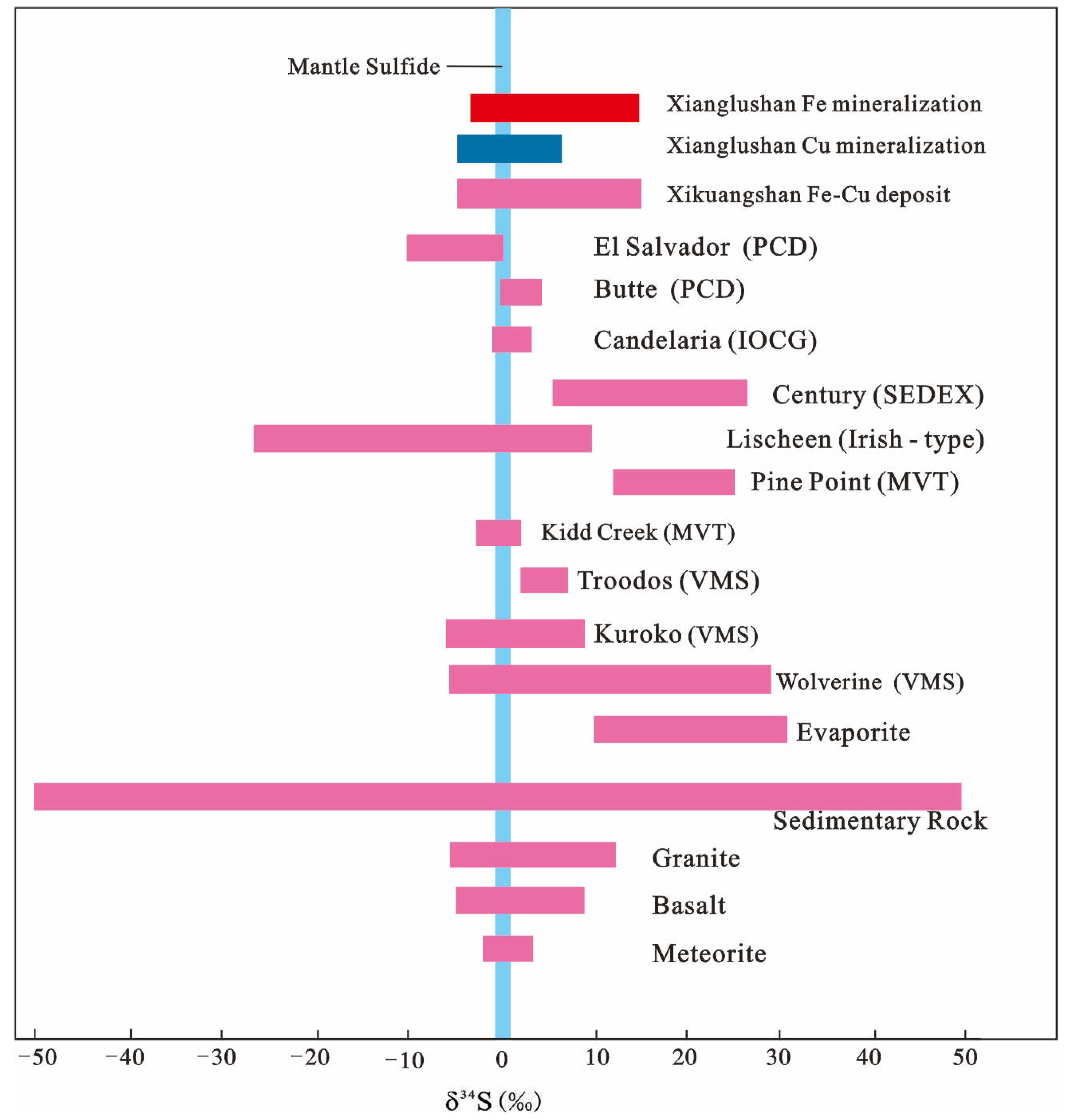
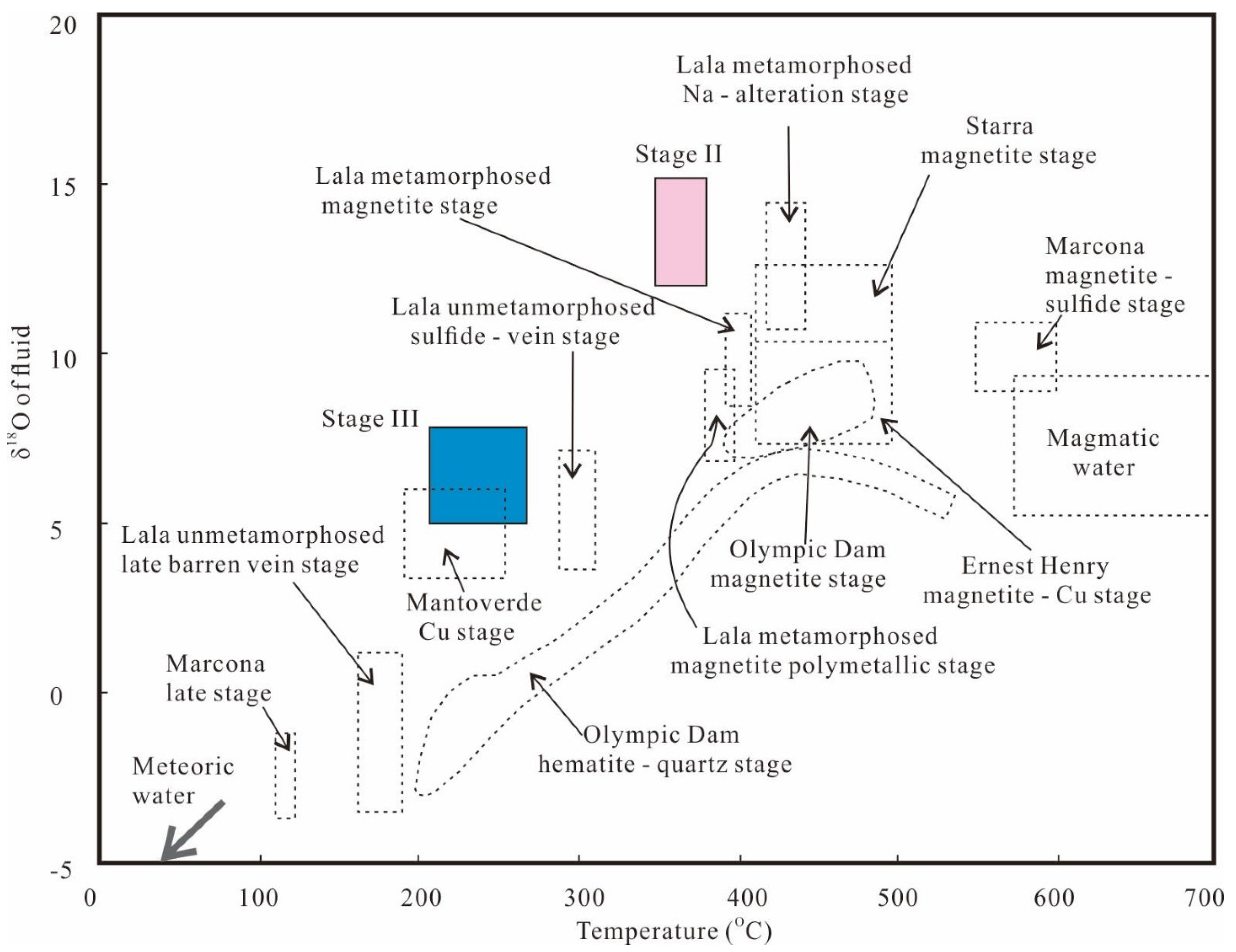
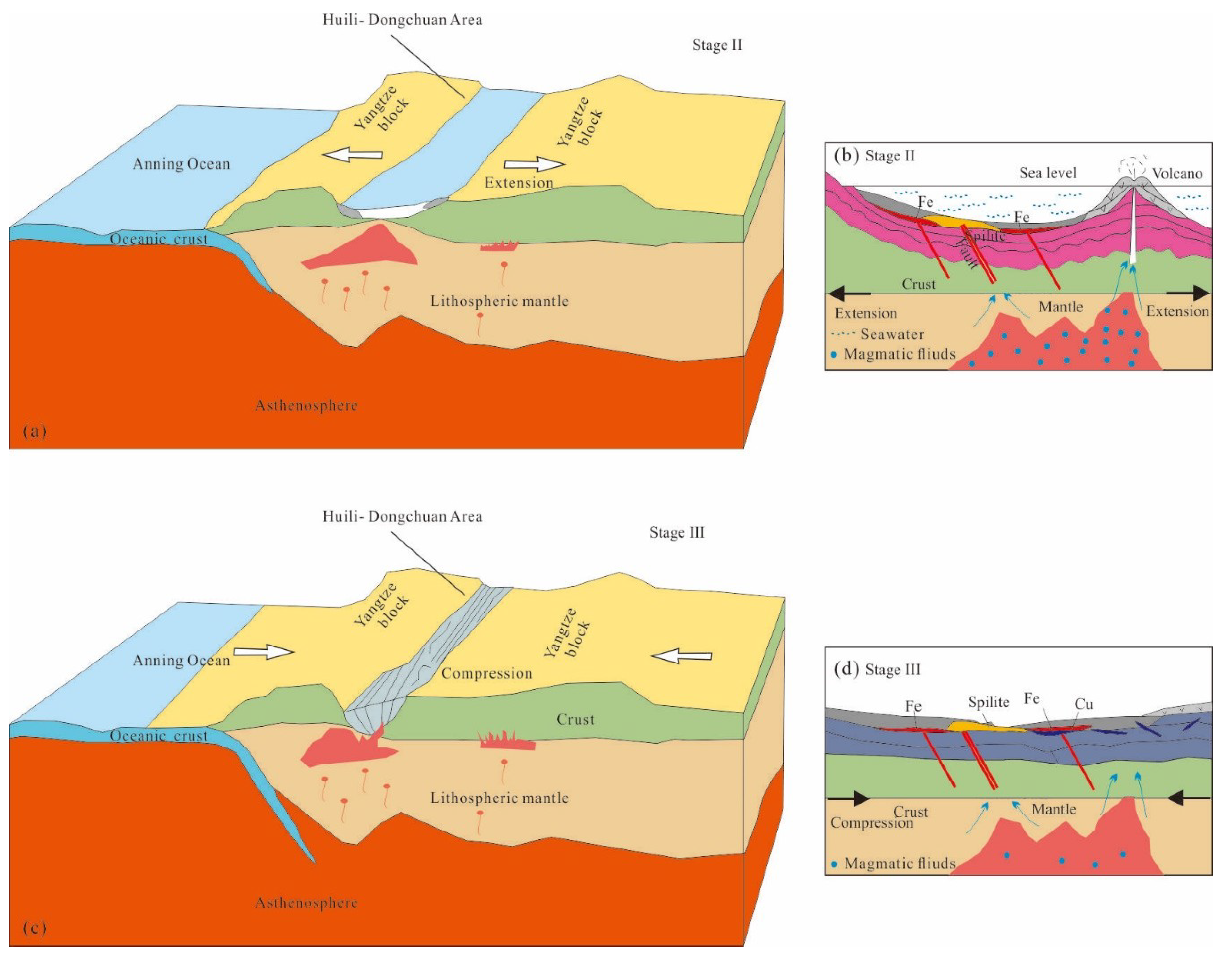
| Sample No. | V/L (%) | Size (μm) | Ore Stage | ||||||
|---|---|---|---|---|---|---|---|---|---|
| S01 | 5 to 20 | 2 to 3 | II | ||||||
| S03 | 5 to 10 | 2 to 6 | |||||||
| S08 | 10 to 15 | 2 to 4 | |||||||
| S09 | 5 to 20 | 2 to 4 | |||||||
| S10 | 10 to 40 | 2 to 9 | III | ||||||
| S11 | 10 to 30 | 2 to 6 | |||||||
| Ore Stage | Mineral | Ice Melting Temp (Tmice/°C) | Homogenization Temp (ThLV/°C) | Salinity (wt % NaCl eqv.) | |||||
| n | Range | Avg. | Range | Avg. | Range | Avg. | |||
| II | Calcite | 42 | −20.8 to −19.2 | −20.2 | 348 to 379 | 361 | 21.8 to 22.9 | 22.4 | |
| III | Calcite | 46 | −20.5 to −18.5 | −19.7 | 206 to 267 | 234 | 19.0 to 22.5 | 20.4 | |
| Sample No. | Mineral | Ore Stage | Liquid Compositions (μg/g) | |||||||||||
|---|---|---|---|---|---|---|---|---|---|---|---|---|---|---|
| F− | Cl− | NO3− | SO42− | K+ | Na+ | Mg2+ | Ca2+ | |||||||
| S01 | Calcite | II | 0.713 | 15.680 | 0.139 | 3.640 | 0.728 | 7.798 | 0.561 | 4.140 | ||||
| S03 | Calcite | 0.322 | 31.060 | 0.209 | 4.261 | 1.437 | 14.120 | 0.621 | 4.630 | |||||
| S08 | Calcite | 0.426 | 27.910 | 0.869 | 5.193 | 1.160 | 13.070 | 1.233 | 9.250 | |||||
| S10 | Calcite | III | 1.165 | 10.350 | 0.242 | 9.630 | 0.452 | 4.666 | 1.209 | 8.610 | ||||
| Sample No. | Mineral | Ore Stage | Gas Compositions (μL/g) | |||||||||||
| H2 | N2 | CO | CH4 | CO2 | H2O | |||||||||
| S01 | Calcite | II | 1.271 | 2.164 | 0.168 | 0.124 | 10.090 | 1.180 × 105 | ||||||
| S03 | Calcite | 0.995 | 1.290 | 0.162 | 0.088 | 10.350 | 1.616 × 105 | |||||||
| S08 | Calcite | 0.989 | 0.389 | 0.200 | 0.090 | 11.870 | 7.517 × 105 | |||||||
| S10 | Calcite | III | 3.460 | 9.971 | 0.336 | 0.446 | 26.790 | 3.522 × 105 | ||||||
| Sample No. | Ore Stage | δ13CPDB‰ | δ18Ov-SMOW‰ | δ18OH2O‰ | Temperature/°C |
|---|---|---|---|---|---|
| S01 | II | −3.9 | 16.2 | 12.7 | 361 |
| S03 | −3.1 | 18.6 | 15.1 | ||
| S08 | −3.3 | 17.7 | 14.2 | ||
| S09 | −4.1 | 15.8 | 12.3 | ||
| S10 | III | −4.6 | 12.4 | 5.0 | 234 |
| S11 | −6.9 | 15.2 | 7.8 |
| Sample No. | Sample Location | Ore Stage | Ore Type | Mineral | δ34SCDT/‰ | 206Pb/204Pb | 207Pb/204Pb | 208Pb/204Pb |
|---|---|---|---|---|---|---|---|---|
| S01 | Xianglushan | II | Stratiform magnetite | Pyrite | 13.7 | 18.211 | 15.657 | 38.280 |
| S02 | Xianglushan | II | Stratiform magnetite | Pyrite | 6.9 | 18.869 | 15.593 | 38.612 |
| S03 | Xianglushan | II | Stratiform magnetite | Pyrite | 11.3 | 17.663 | 15.498 | 37.812 |
| S04 | Xianglushan | II | Stratiform magnetite | Pyrite | 3.2 | 18.768 | 15.696 | 38.972 |
| S06 | Yaopengzi | II | Stratiform magnetite | Pyrite | 3.3 | 18.635 | 15.743 | 38.985 |
| S08 | Yaopengzi | II | Stratiform magnetite | Pyrite | 6.7 | 18.982 | 15.824 | 37.784 |
| S09 | Yaopengzi | II | Stratiform magnetite | Pyrite | 2.8 | 18.756 | 15.812 | 37.952 |
| S12 | Yaopengzi | II | Stratiform magnetite | Pyrite | −3.3 | 18.596 | 15.736 | 38.823 |
| S05 | Xianglushan | III | Stockwork sulfide | Chalcopyrite | 0.9 | 18.234 | 15.755 | 37.658 |
| S07 | Xianglushan | III | Stockwork sulfide | Chalcopyrite | 5.2 | 18.676 | 15.534 | 38.882 |
| S10 | Yaopengzi | III | Stockwork sulfide | Chalcopyrite | −2.6 | 18.987 | 15.876 | 39.476 |
| S11 | Yaopengzi | III | Stockwork sulfide | Chalcopyrite | −4.6 | 18.198 | 15.581 | 38.127 |
© 2019 by the authors. Licensee MDPI, Basel, Switzerland. This article is an open access article distributed under the terms and conditions of the Creative Commons Attribution (CC BY) license (http://creativecommons.org/licenses/by/4.0/).
Share and Cite
Wang, T.; Lai, C.; Li, H. Geology and Genesis of Xianglushan Fe-Cu Orefield in Sichuan (SW China): Evidence from C-O-S-Pb Isotopes. Minerals 2019, 9, 338. https://doi.org/10.3390/min9060338
Wang T, Lai C, Li H. Geology and Genesis of Xianglushan Fe-Cu Orefield in Sichuan (SW China): Evidence from C-O-S-Pb Isotopes. Minerals. 2019; 9(6):338. https://doi.org/10.3390/min9060338
Chicago/Turabian StyleWang, Tianguo, Chunkit Lai, and Huan Li. 2019. "Geology and Genesis of Xianglushan Fe-Cu Orefield in Sichuan (SW China): Evidence from C-O-S-Pb Isotopes" Minerals 9, no. 6: 338. https://doi.org/10.3390/min9060338
APA StyleWang, T., Lai, C., & Li, H. (2019). Geology and Genesis of Xianglushan Fe-Cu Orefield in Sichuan (SW China): Evidence from C-O-S-Pb Isotopes. Minerals, 9(6), 338. https://doi.org/10.3390/min9060338






